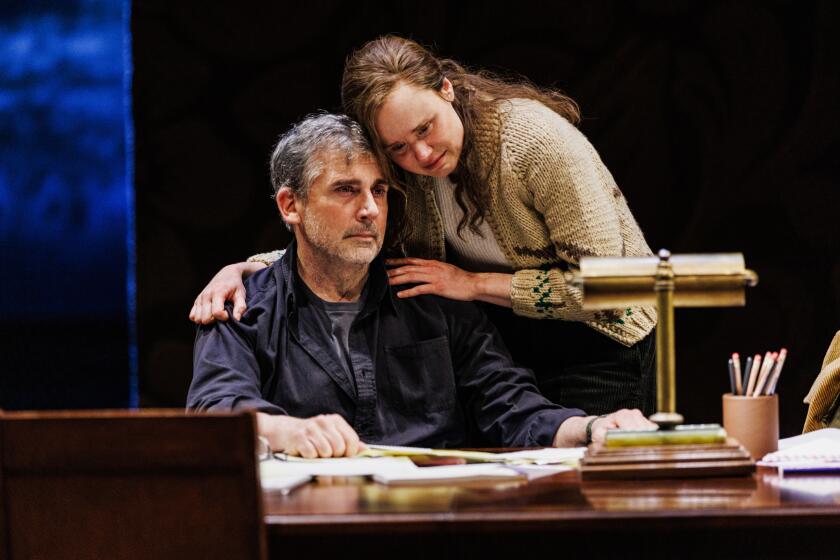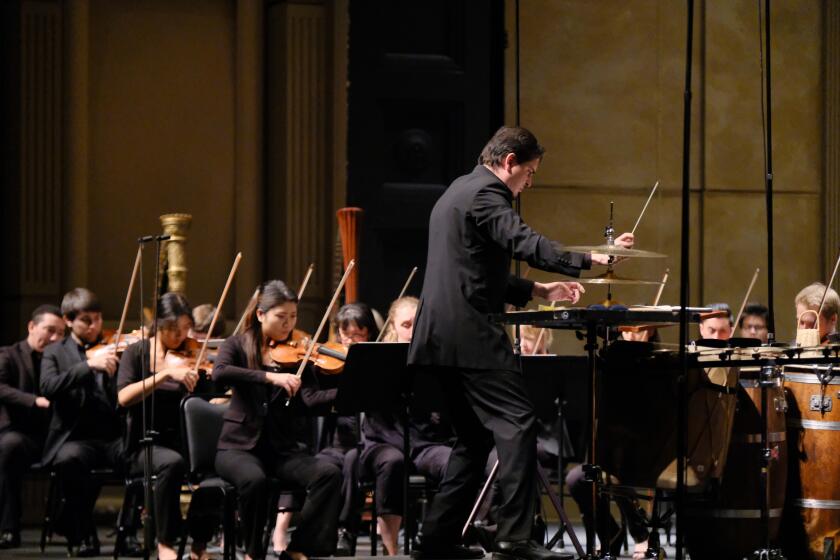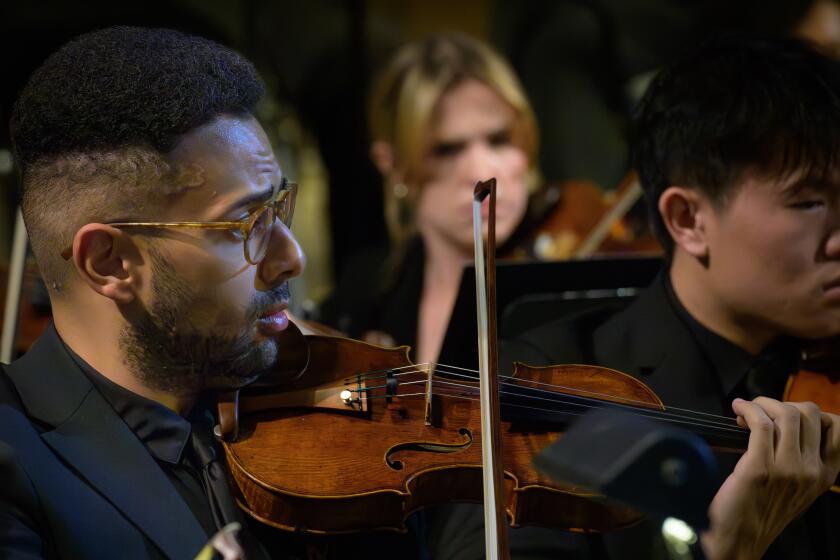Uniting the Americas
What’s new at the Santa Barbara Museum of Art? Just about everything but the collection. And that, too, looks different. In the first big project launched by director Phillip M. Johnston, who took charge less than a year ago, the museum has transformed its galleries and reinstalled a major portion of its permanent collection in an unorthodox exhibition with grand ambitions.
Outside on State Street -- where the 63-year-old museum occupies a chunk of prime real estate in a bustling commercial district -- colorful banners and a huge bronze mother and child by Colombian artist Fernando Botero all but shout that something really big is going on: “Art of the Americas: Latin America and the United States, 1800 to Now!”
Inside the museum, “Right You Are If You Think You Are,” a politically charged diptych by Brazilian artist Nelson Leirner, grabs attention. His side-by-side maps of the Americas, composed of tiny images of skeletons and Disney cartoon characters, lead to a profusion of about 200 paintings, drawings, sculptures, prints, photographs and installations by artists from North, South and Central America.
This is no standard survey, with works lined up in chronological order or clustered in geographic sections. Hung salon-style and organized by subject matter and visual relationships, the show compels visitors to forget national boundaries and historic periods and pay attention to thematic and formal correspondences over a wide span of time and place. The goal, in short, is to shake up old ways of looking at art.
“We wanted to ask what it means to be an American,” says Diana C. du Pont, the museum’s curator of modern and contemporary art, who organized the sprawling exhibition. “The Americas share a history marked by colonialism and revolution. That shared history is reflected in art, but museums rarely exhibit art of the United States and Latin America side by side on an equal footing. We wanted to make our collection relevant.”
The exhibition may not tell visitors what it means to be an American, but it offers a chorus -- perhaps a cacophony -- of suggestions. Pairs and groups of artworks that wouldn’t be expected to appear in the same room, much less on the same wall, suddenly seem to have a lot in common as they strike up visual conversations and upset the usual balances of power.
Lone women lost in thought, painted by Mexican artist Rafael Coronel in 1967 and U.S. painter Richard Diebenkorn in 1956, evoke a similar mood despite differences in the artists’ styles and sensibilities. Compartmentalized abstractions created by Uruguayan artist Joaquin Torres-Garcia in 1932 and U.S. Abstract Expressionist Adolph Gottlieb in 1947 seem to have sprouted from the same thought process.
“Rebellious Silence,” a 1994 photograph by Iranian American Shirin Neshat depicting a veiled woman whose face is partly covered with text, hangs near “Two Indian Women,” a 1930 painting of shrouded figures by Mexican painter David Alfaro Siqueiros. A 1959 painting of a nude by Mexican artist Ricardo Martinez, inspired by pre-Columbian art, bears an eerie figure-as-landscape resemblance to U.S. photographer Judy Dater’s 1981 image of herself curled up nude in the desert.
Other neighboring artworks present sharp differences in attitude. “Buffalo Hunter,” a mid-19th century painting by an anonymous artist, glorifies the romantic notion of the Native American as noble savage, while Fritz Scholder’s 1970 painting, “Indian with Three Faces,” attacks the stereotype. William Merritt Chase’s 1886 full-length portrait of his wife as a demure lady in a long, pink gown could hardly be more different from Walt Kuhn’s “Trude,” a 1931 painting of a woman facing her audience in nothing but red and black underwear, a necklace and high-heeled shoes.
Investigating the collection
Conceived as a yearlong series of exhibitions, with the current attraction as its long-running centerpiece, “Art of the Americas” emerged from a small traveling show and a changing of the guard in Santa Barbara. “In the American Grain: Arthur Dove, Marsden Hartley, John Marin, Georgia O’Keeffe and Alfred Stieglitz” -- a show of 40 paintings from the Phillips Collection in Washington, D.C., that inaugurated the series and remains on view through May 9 -- was booked under the previous administration.
When Johnston came aboard, he asked Du Pont to coordinate “In the American Grain.” She agreed, but with the proviso that they reinstall the museum’s American collection. Her ambitious proposal suited the new director, who saw an opportunity.
“Like most museums, we have far more works in our collection than we can show,” says Johnston, a decorative arts specialist who has led the Carnegie Museum of Art in Pittsburgh and the Rhode Island School of Design’s Museum of Art in Providence. “And since I have a particular interest in American art, I had wondered how we might investigate our American collection. From a selfish point of view, this was a way for me to get to know the collection.”
In art history parlance, American art usually means art made in the United States. But that wasn’t what Johnston and Du Pont had in mind.
“With this museum,” Johnston says, “when you talk about American, you are talking about North and South. And philosophically it just makes so much sense to get them together not by geographic categories but by artistic interest. Diana really picked that up; she thinks that way.”
Du Pont got to work, sifting through the collection and creating a conceptual framework that would present the works in four sections: people; places; things and things abstracted; and art, society and politics. Within those categories she developed themes inspired by books and films, including “Representing Women,” “The Poetry of Things,” “The Hero With a Thousand Faces” and “History and Identity.”
The next challenge was how to present the show. The solution came from Los Angeles architect Frederick Fisher. A specialist in museums and galleries, he and partners Joseph Coriaty and David Ross have designed P.S. 1 Contemporary Art Center in New York and the Long Beach Museum of Art’s new building. A current project is a major new gallery at the Huntington Library in San Marino.
“I knew Phillip when he was at the Carnegie and the Rhode Island School of Design,” Fisher says, “but his inquiry came out of the blue. He and Diana wanted to see how I might rethink the galleries. I do exhibition design every so often, and I enjoy it because it happens quickly and less painfully than buildings. It also helps me see how curators and directors use buildings and gives me a perspective from the user’s point of view.”
In this case, Fisher had to work with an Italianate building that began its life in 1915 as a 12,000-square-foot post office. By 1941, when the museum was founded, the building had been abandoned. The fledgling museum moved in with a collection of 65 objects. After many art acquisitions and facility expansions, the museum now maintains about 25,000 American, European and Asian artworks in a 56,623-square-foot building. Art of the Americas is just one component of a broad and ever-expanding collection that includes Greek and Roman antiquities, Chinese textiles and ceramics, Japanese prints and lacquerware, 19th and 20th century French paintings and some 7,000 photographs.
Like most museums, the Santa Barbara institution usually copes with changing exhibitions by installing temporary walls. Fisher drew inspiration from Italian architect and exhibition designer Carlo Scarpa, who transformed historic buildings into museums in Italy after World War II -- and delighted in devising personal “interventions” that provide a modern counterpoint to the original structures.
“I’m kind of a Surrealist at heart,” Fisher says. “I like juxtapositions that make you see things in a different way.”
Instead of filling the galleries with a maze of new walls, he cleared them out and uncovered the skylight in the McCormick Gallery, the largest exhibition space. That left less wall space than Du Pont thought she needed, but she accommodated almost all the works on her checklist -- some in the salon-style hanging, others in Fisher’s version of Scarpa’s “interventions.”
The idea was to create a series of modern objects, to be used for display, that would provide a sharp contrast to the architecture and a thread of continuity for the exhibition. An easel-like structure at the entrance supports the Leirner diptych. Another “intervention,” in a gallery devoted to depictions of place, resembles a Japanese folding screen. A rectangular box-like enclosure for “The Jefferson Suite” installation by Carrie Mae Weems is a sort of sculptural monolith, Fisher says.
With lots of art to be assembled in wide-open spaces, Fisher thought the galleries needed color and graphics to separate thematic sections and to help visitors find their way. He enlisted architectural colorist Scott Flax to devise a family of colors for the gallery walls. Graphic artists Tim McNeil and Christopher Muniz designed printed materials, banners and exhibition graphics.
“It was a real collaborative process,” Fisher says.
Start with the art
The museum is not alone in grappling with hierarchies of American art. The Los Angeles County Museum of Art, Boston’s Museum of Fine Arts and the Dallas Museum of Art have begun to integrate their collections of works made in the United States and Canada with those from Latin America. At Houston’s Museum of Fine Arts, which recently established its International Center for the Arts of the Americas, the big summer attraction will be “Inverted Utopias: Avant-Garde Art in Latin America,” billed as the first U.S. exhibition devoted to Latin American artists’ contributions to the 20th century vanguard.
But despite its relatively small size, the Santa Barbara museum aims to be in the forefront of the movement.
“We hope that ‘Art of the Americas’ will provide a stimulating example of new ways to present American art and a model for the interpretation and display of permanent collections,” Du Pont says.
Should anyone choose to follow the model, the secret is to start with the art, Johnston says. “I was thrilled that Diana approached the process in the way she did. It was not about imposing any thesis or intellectual strategy. She really said, ‘Let’s look at the art, let’s look at it together.’ ”
Whether they can do the same thing with other parts of the collection remains to be seen, Johnston says. “We are intrigued by the possibility, now that we have put the Americas together, to see if that would be a fulfilling way to look at the Western world. But we are just starting to talk about that.”
*
‘Art of the Americas: Latin America and the United States, 1800 to Now!’
Where: Santa Barbara Museum of Art, 1130 State St., Santa Barbara
When: Tuesdays to Thursdays and Saturdays, 11 a.m. to 5 p.m.; Fridays, 11 a.m. to 9 p.m.; Sundays, noon to 5 p.m.
Ends: Nov. 21
Price: $4-$7
Contact: (805) 963-4364
More to Read
The biggest entertainment stories
Get our big stories about Hollywood, film, television, music, arts, culture and more right in your inbox as soon as they publish.
You may occasionally receive promotional content from the Los Angeles Times.






